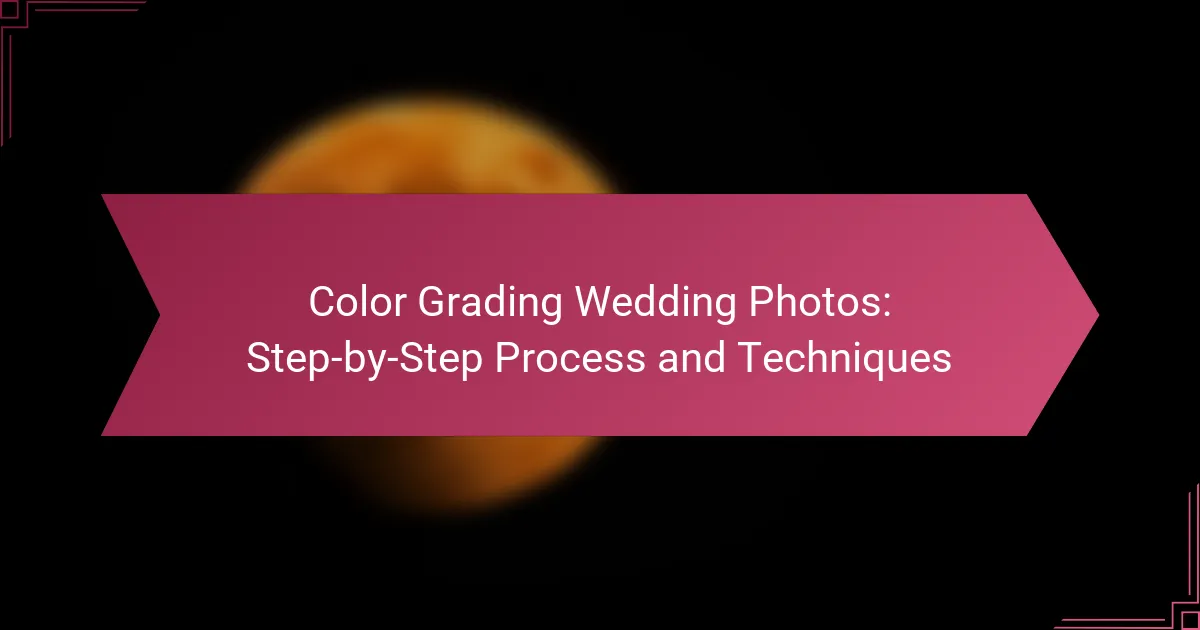Color grading wedding photos is a vital step in enhancing the emotional depth and visual appeal of the images. By utilizing techniques such as split toning and curves adjustment, photographers can create a cohesive look that reflects the couple’s unique style and the atmosphere of their special day. Choosing the right editing software, like Adobe Lightroom or Capture One Pro, is essential for achieving stunning results.
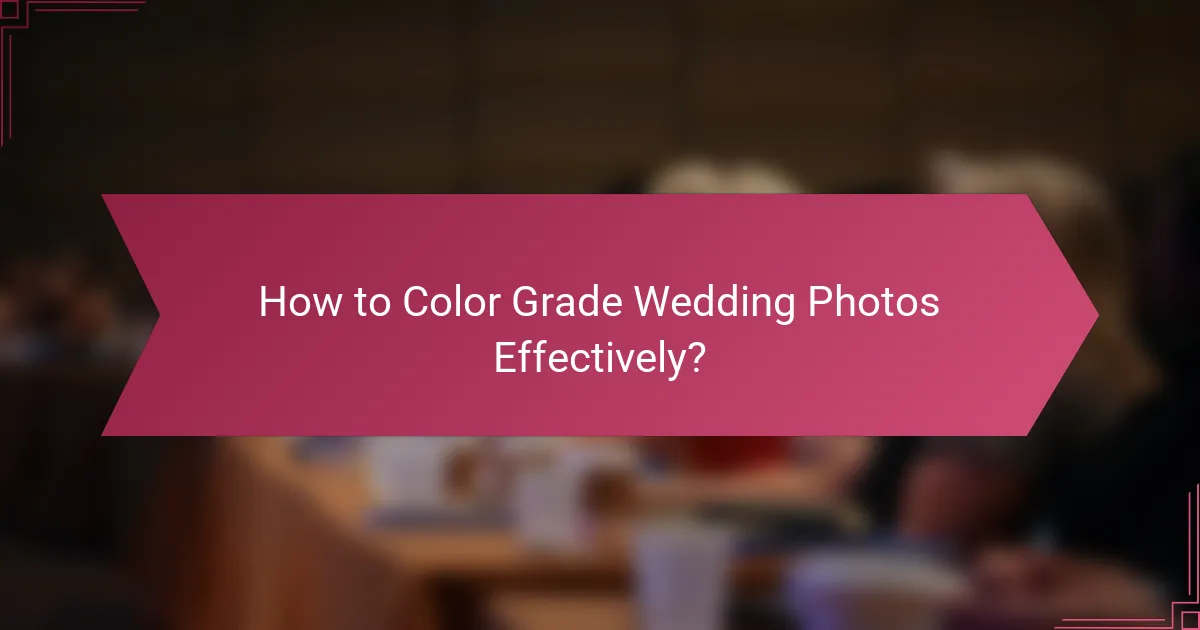
How to Color Grade Wedding Photos Effectively?
Color grading wedding photos effectively involves enhancing the images to evoke emotions and create a cohesive look. This process can significantly improve the visual storytelling of the wedding day, making the photos more memorable.
Use Lightroom for color grading
Lightroom is a powerful tool for color grading wedding photos, offering a user-friendly interface and extensive features. Start by importing your images and using the Develop module to access various color grading options.
Utilize the Basic panel to adjust exposure, contrast, highlights, and shadows, which sets the foundation for your color grading. The HSL (Hue, Saturation, Luminance) panel allows for more precise adjustments to specific colors, helping to achieve the desired mood.
Apply color grading presets
Color grading presets can save time and provide a consistent look across your wedding photos. Many photographers create their own presets or purchase them from online marketplaces, tailored specifically for wedding photography.
When applying presets, ensure they complement the lighting conditions and color palette of the wedding day. Adjust the intensity of the preset as needed to maintain a natural appearance while achieving the desired artistic effect.
Adjust white balance and exposure
Correcting white balance is crucial for accurate color representation in wedding photos. Use the eyedropper tool in Lightroom to select a neutral area in the image, or manually adjust the temperature and tint sliders to achieve the desired warmth or coolness.
Exposure adjustments are equally important; aim for a balanced exposure that highlights the couple and key details without losing information in the highlights or shadows. A good rule of thumb is to keep the histogram centered to avoid clipping.
Utilize color wheels for fine-tuning
Color wheels in Lightroom allow for targeted adjustments to shadows, midtones, and highlights. This feature is particularly useful for enhancing skin tones and creating a specific mood in your wedding photos.
When using color wheels, consider the emotional tone you want to convey. For a romantic feel, warmer tones in the highlights and midtones can be effective, while cooler tones can evoke a more dramatic atmosphere.
Experiment with LUTs for creative effects
Lookup Tables (LUTs) can add unique color grading styles to your wedding photos. These are especially popular for achieving cinematic looks or specific color palettes that align with the couple’s vision.
When applying LUTs, ensure they enhance rather than overpower the natural beauty of the images. It’s advisable to adjust the opacity of the LUT to blend it seamlessly with your base edits, maintaining a natural look while adding creative flair.
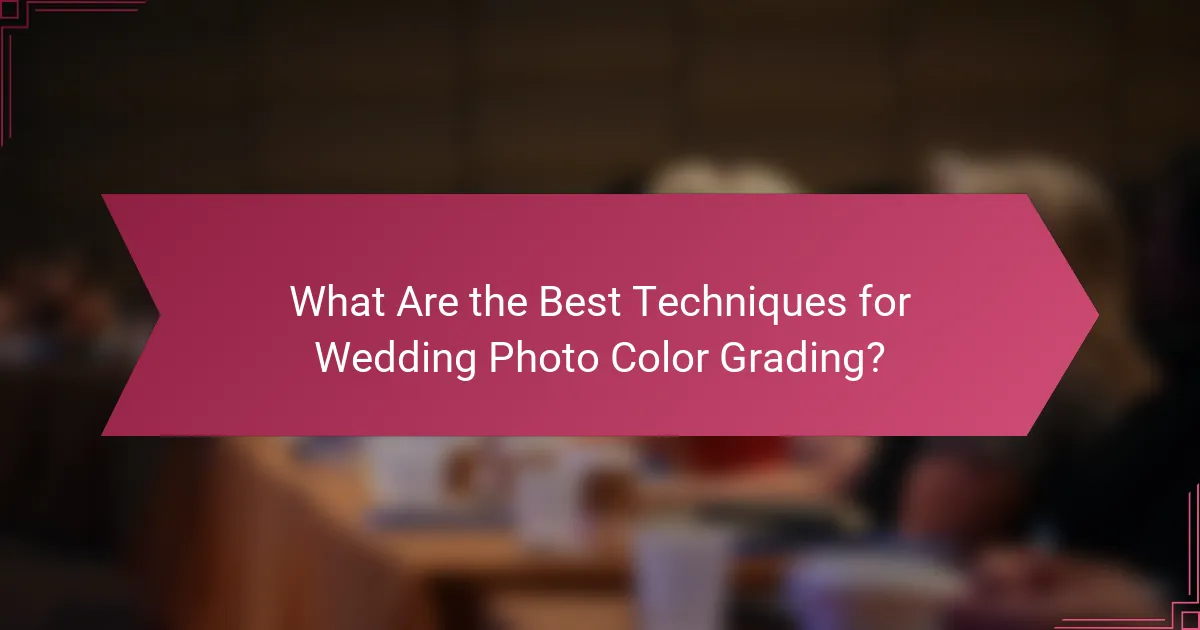
What Are the Best Techniques for Wedding Photo Color Grading?
The best techniques for wedding photo color grading include split toning, curves adjustment, color correction, and using HSL sliders. Each method enhances the visual appeal and emotional impact of the images, ensuring they reflect the couple’s unique style and the atmosphere of the day.
Split toning for mood enhancement
Split toning involves adding different colors to the highlights and shadows of an image, which can significantly enhance the mood. For instance, warm tones in the highlights can create a romantic feel, while cooler shadows can add depth. This technique is particularly effective in wedding photography, where conveying emotion is key.
To apply split toning, start with subtle adjustments, such as adding a soft peach to highlights and a muted blue to shadows. Avoid extreme color shifts that can make the photo look unnatural. Aim for a balanced look that complements the overall color palette of the wedding.
Curves adjustment for contrast
Curves adjustment is a powerful tool for controlling contrast and brightness in wedding photos. By manipulating the curve line, you can enhance the tonal range, making the image pop. A typical approach is to create an S-curve, which brightens highlights and deepens shadows, adding dimension to the photo.
When using curves, be mindful of clipping, where details in highlights or shadows are lost. It’s best to make small adjustments and preview the changes frequently. This technique works well for both indoor and outdoor settings, helping to maintain a natural look while enhancing visual interest.
Color correction for skin tones
Color correction is essential for achieving natural-looking skin tones in wedding photos. This process involves adjusting the colors to ensure that skin appears healthy and true to life. Pay attention to the white balance and make adjustments based on the lighting conditions, whether it’s warm candlelight or bright daylight.
A common practice is to use the eyedropper tool to select a neutral point in the image, which helps in correcting any color casts. Additionally, consider using selective color adjustments to fine-tune skin tones without affecting the rest of the image. This ensures that the couple looks their best on their special day.
Using HSL sliders for targeted adjustments
HSL sliders allow for precise control over hue, saturation, and luminance of specific colors in your wedding photos. This targeted approach enables you to enhance or mute certain colors without impacting the entire image. For example, you can boost the saturation of greens in the foliage while keeping the skin tones natural.
When using HSL sliders, focus on the colors that are most prominent in the scene. Adjusting saturation and luminance can help create a more cohesive look across the wedding album. Be cautious with extreme adjustments, as they can lead to unrealistic results. Aim for subtle enhancements that maintain the authenticity of the moment.
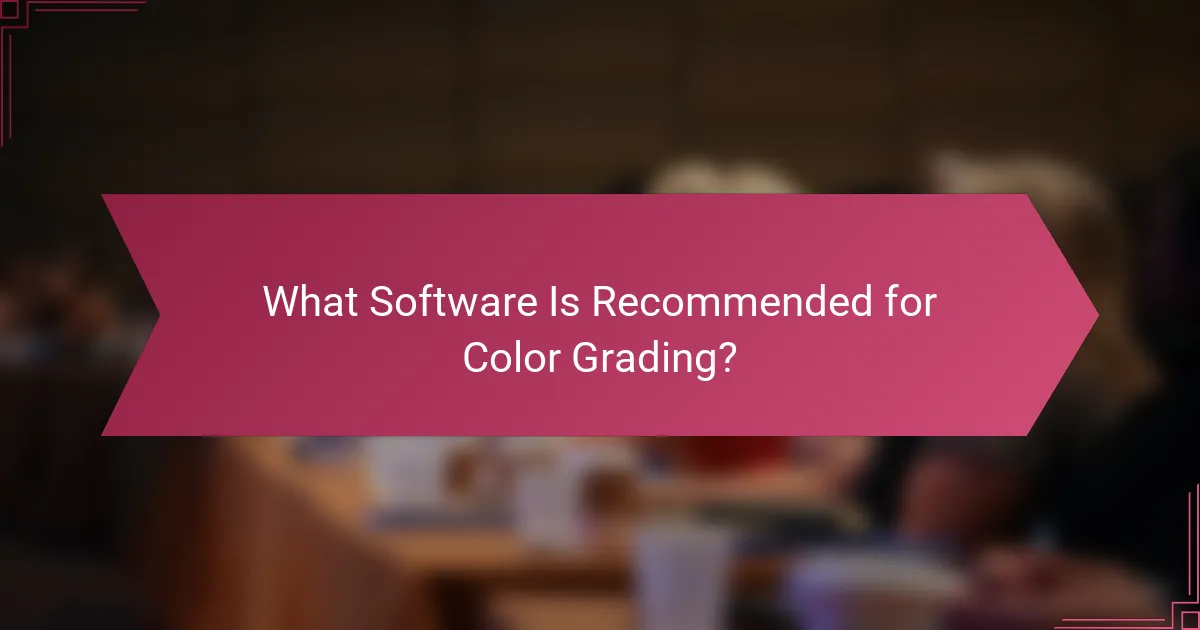
What Software Is Recommended for Color Grading?
For effective color grading of wedding photos, software that offers robust editing tools and flexibility is essential. Popular choices include Adobe Lightroom, Adobe Photoshop, Capture One Pro, and DaVinci Resolve, each catering to different needs and preferences.
Adobe Lightroom
Adobe Lightroom is a favorite among wedding photographers for its user-friendly interface and powerful color grading capabilities. It allows for non-destructive editing, meaning you can adjust colors without permanently altering the original image.
Key features include presets for quick adjustments, advanced color sliders, and the ability to work with RAW files. This makes it ideal for batch processing, allowing you to maintain a consistent look across multiple images efficiently.
Adobe Photoshop
Adobe Photoshop provides extensive tools for detailed color grading, making it suitable for photographers who want to fine-tune every aspect of their images. Its layer-based editing system allows for precise adjustments and creative effects.
While it has a steeper learning curve than Lightroom, Photoshop excels in tasks like selective color adjustments and advanced blending modes. This software is best for photographers who need to perform intricate edits on individual photos rather than bulk processing.
Capture One Pro
Capture One Pro is known for its exceptional color grading capabilities, particularly with RAW files. It offers advanced color wheels and a range of tools for fine-tuning hues, saturation, and luminance, making it a top choice for professional photographers.
Its tethering capabilities are also a significant advantage during shoots, allowing real-time adjustments. However, it may require a higher investment compared to other software, making it more suitable for serious professionals.
DaVinci Resolve
DaVinci Resolve is primarily known for video editing but has powerful color grading tools that can enhance wedding photos as well. Its node-based interface allows for complex color adjustments and creative grading techniques.
This software is particularly beneficial for photographers who also work with video, as it provides a comprehensive suite for both mediums. While it can be more complex to learn, the depth of control it offers is unmatched for those willing to invest the time.
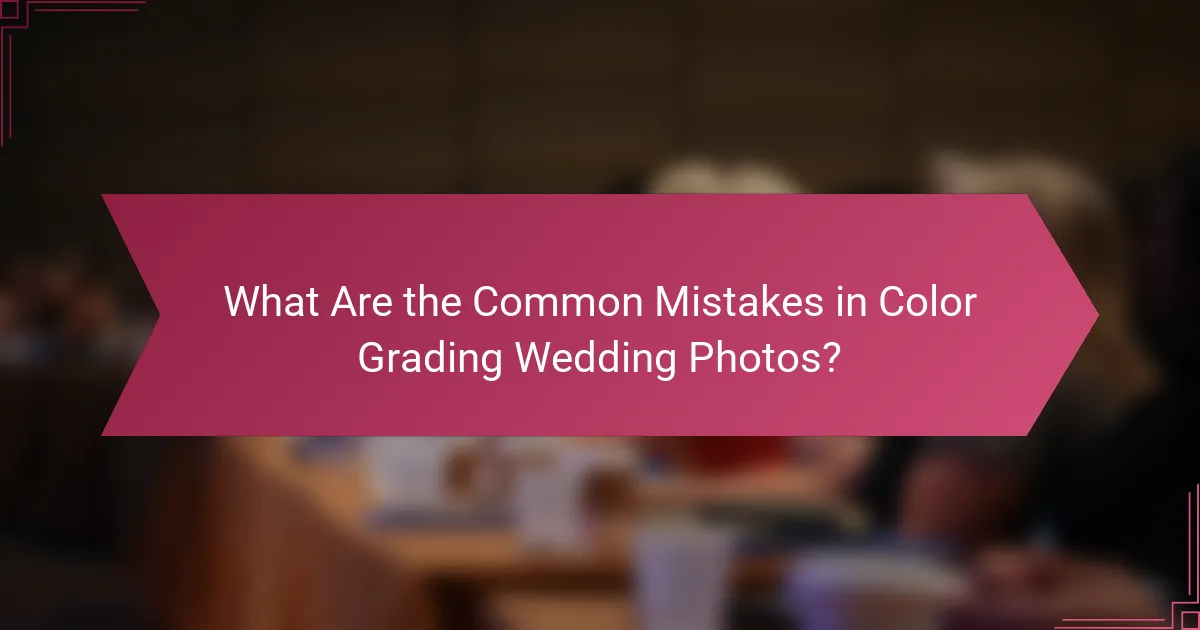
What Are the Common Mistakes in Color Grading Wedding Photos?
Common mistakes in color grading wedding photos include over-saturation of colors and neglecting skin tone accuracy. These errors can lead to unrealistic images that do not reflect the true emotions and beauty of the day.
Over-saturation of colors
Over-saturation occurs when colors are intensified beyond their natural vibrancy, resulting in images that look artificial. This often happens when photographers try to enhance the mood or atmosphere but end up distorting the original colors.
To avoid over-saturation, aim for a balanced color palette that maintains the integrity of the scene. Use tools like histograms to monitor color levels and ensure they remain within a natural range. A good rule of thumb is to keep saturation adjustments to a minimum, typically no more than 10-20% increase.
Ignoring skin tone accuracy
Ignoring skin tone accuracy can lead to unflattering results, where subjects appear overly orange, pink, or gray. Capturing true-to-life skin tones is crucial for wedding photos, as these images often feature family and friends in emotional moments.
To maintain accurate skin tones, use a color checker during the shoot and adjust white balance accordingly in post-processing. When editing, focus on subtle adjustments rather than drastic changes, ensuring skin tones remain consistent across different lighting conditions. A practical tip is to compare skin tones against a reference image to ensure they look natural.
